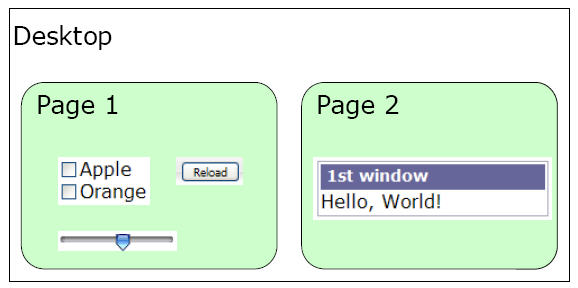Page and Desktop
![]() This documentation is for an older version of ZK. For the latest one, please click here.
This documentation is for an older version of ZK. For the latest one, please click here.
Page: created for each ZUML
A page (Page ) is a collection of components. A page confines components belonging to it, such that they will be displayed in a certain portion of the browser. A page is automatically created when ZK loader interprets a ZUML page.
Desktop: for serving the same URL request
A ZUML page might include another ZUML pages directly or indirectly. Since these pages are created for serving the same URL request, they are collectively called a desktop (Desktop ). In other word, a desktop is a collection of pages for serving the same URL request for one user. As a ZK application interacts with user, more pages might be added to a desktop and some might be removed from a desktop. Similarly, a component might be added to or removed from a page.
Notice that both pages and desktops are created and remove implicitly. There are no API to create or remove them. A page is create each time ZUML loads a page. A page is removed when ZK finds it is no longer referenced. A desktop is created when the first ZUML page is loaded.
Implicit Objects
Besides components created by user, there are implicit objects created automatically. These implicit objects enable developers to access components more efficiently, get information about system, client. And developer may utilize implicit objects to pass variables. Implicit objects include: self, spaceOwner, page, desktop, execution, session, application, componentScope, spaceScope, pageScope, desktopScope, sessionScope, applicationScope, requestScope, arg, each, forEachStatus, event
The corresponding java classes of implicit objects are located at Package org.zkoss.zk.ui
Please refer to Implicit Objects for detailed explanation.
